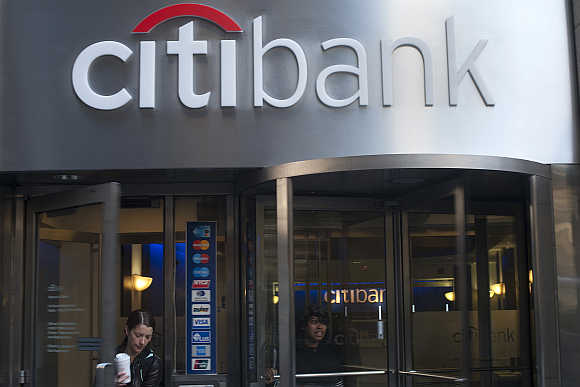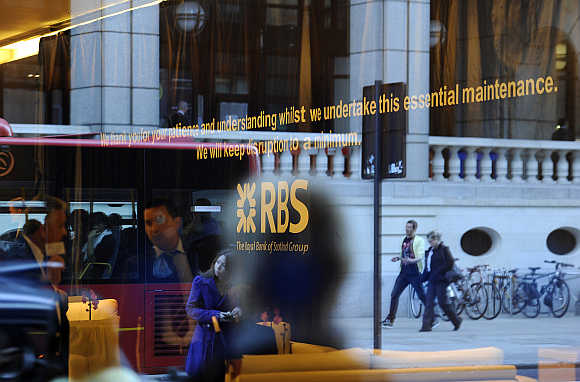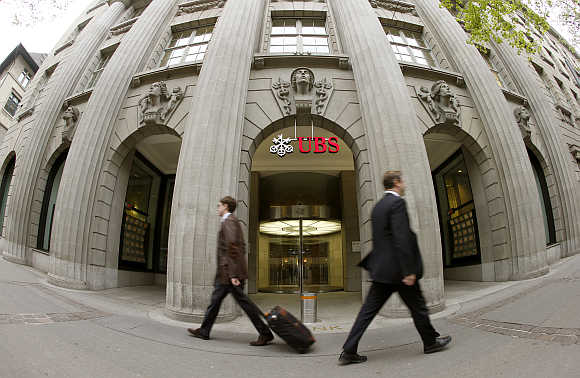Photographs: Neil Hall/Reuters Dominic Elliott in London
When traders got caught fiddling Libor, their employers blamed a few bad apples. Singapore has found 133 people at 20 banks trying to rig three rates. That sounds more like a rotten barrel.
The four banks previously rapped for Libor were hounded on a case-by-case basis. For those lenders - Barclays, Citigroup, Royal Bank of Scotland and UBS - the spotlight accentuated the humiliation.
Singapore's central bank has spared each of the banks that fiddled rates on its turf that embarrassment. Yet the collective blame makes the industry look worse. The banks avoid the loss of business to competitors, since nearly everyone seems to have been involved.
...
Bank rate-rigging was pretty big business
Image: Citibank branch in New York.Photographs: Keith Bedford/Reuters
They also avoid fines, presumably because attempted rate manipulation was not a criminal offence at the time. Instead, 19 of the 20 censured banks will have to pony up additional cash reserves for one year, up to a total of $10 billion.
The reserves are effectively an interest-free loan to the Singaporean government for a year, and a deferred prosecution agreement: the additional reserves will not be returned until the central bank has approved changes to rate-setting processes.
The Monetary Authority of Singapore may have found no "conclusive" evidence that any trader actually succeeded in gaming the system.
...
Bank rate-rigging was pretty big business
Image: Pedestrians are reflected in the window of a Royal Bank of Scotland building in the City of London.Photographs: Paul Hackett/Reuters
But the attempts were systematic, over four years, from 2007 to 2011, and involved three different benchmark rates: Sibor, the interbank rate that is Singapore's equivalent to Libor, a swap offer rate for commercial and mortgage lending; and a forward currency benchmark rate.
The attempted fix in the foreign-exchange market chimes with an investigation under way by the UK regulator.
In one jurisdiction or another, the process of setting benchmark prices for gold, credit-default swaps, and oil and gas contracts are under scrutiny. It appears benchmarks entice abuse like flowers attract bees.
...
Bank rate-rigging was pretty big business
Image: People walk past the headquarters of Swiss bank UBS in Zurich, Switzerland.Photographs: Arnd Wiegmann/Reuters
The International Organization of Securities, which is leading global efforts to reform rate-setting processes, says benchmarks should be based on actual transactions. There are also too many: Singapore alone had 11.
The city island-state's cleanup thus offers a glimmer of light - six rates are being discontinued and four of the remaining five will now be based on actual trade data, not on traders' possibly twisted imaginings.
Context news
i) Singapore's central bank reprimanded 20 banks on June 14 after finding that 133 traders attempted to rig three benchmark rates over four years.
ii) The Monetary Authority of Singapore ordered 19 of the banks to set aside additional cash reserves for the period of one year and will require them to report on their progress in toughening up their rate-setting processes each quarter.
...
Bank rate-rigging was pretty big business
Image: Employees of ING group during their lunch break in front of their office in Amsterdam, the Netherlands.Photographs: Michael Kooren/Reuters
iii) ING, Royal Bank of Scotland and UBS are the hardest hit of the banks, with each facing an additional cash reserve requirement of between 1 to 1.2 billion Singaporean dollars ($0.8 to $1 billion).
The other banks required to boost their cash reserves are: Bank of America, BNP Paribas , Oversea-Chinese Banking Corporation, Barclays, Credit Agricole, Credit Suisse, DBS, Deutsche Bank, Standard Chartered , United Overseas Bank, Australia and New Zealand Banking Group, Citibank, JPMorgan, Macquarie, Bank of Tokyo-Mitsubishi UFJ and HSBC. Commerzbank was censured but given no additional reserve requirement.







article